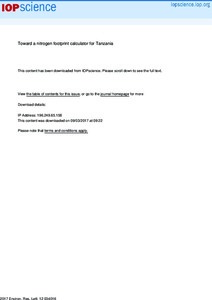| dc.contributor.author | Hutton, M.O. |
| dc.contributor.author | Leach, A. |
| dc.contributor.author | Leip, A. |
| dc.contributor.author | Galloway, J.N. |
| dc.contributor.author | Bekunda, Mateete A. |
| dc.contributor.author | Sullivan, C. |
| dc.contributor.author | Lesschen, J.P. |
| dc.date.accessioned | 2019-12-04T11:07:52Z |
| dc.date.available | 2019-12-04T11:07:52Z |
| dc.date.issued | 2017 |
| dc.identifier.citation | Hutton, M.O., Leach, A., Leip, A., Galloway, J.N., Bekunda, M., Sullivan, C. & Lesschen, J.P. (2017). Toward a nitrogen footprint calculator for Tanzania. Environmental Research Letters, 12. |
| dc.identifier.issn | 1748-9326 |
| dc.identifier.uri | https://hdl.handle.net/20.500.12478/1631 |
| dc.description | Open Access Journal |
| dc.description.abstract | We present the first nitrogen footprint model for a developing country: Tanzania. Nitrogen (N) is a crucial element for agriculture and human nutrition, but in excess it can cause serious environmental damage. The Sub-Saharan African nation of Tanzania faces a two-sided nitrogen problem: while there is not enough soil nitrogen to produce adequate food, excess nitrogen that escapes into the environment causes a cascade of ecological and human health problems. To identify, quantify, and contribute to solving these problems, this paper presents a nitrogen footprint tool for Tanzania. This nitrogen footprint tool is a concept originally designed for the United States of America (USA) and other developed countries. It uses personal resource consumption data to calculate a per-capita nitrogen footprint. The Tanzania N footprint tool is a version adapted to reflect the low-input, integrated agricultural system of Tanzania. This is reflected by calculating two sets of virtual N factors to describe N losses during food production: one for fertilized farms and one for unfertilized farms. Soil mining factors are also calculated for the first time to address the amount of N removed from the soil to produce food. The average per-capita nitrogen footprint of Tanzania is 10 kg N yr−1. 88% of this footprint is due to food consumption and production, while only 12% of the footprint is due to energy use. Although 91% of farms in Tanzania are unfertilized, the large contribution of fertilized farms to N losses causes unfertilized farms to make up just 83% of the food production N footprint. In a developing country like Tanzania, the main audiences for the N footprint tool are community leaders, planners, and developers who can impact decision-making and use the calculator to plan positive changes for nitrogen sustainability in the developing world. |
| dc.format.extent | 1-12 |
| dc.language.iso | en |
| dc.subject | Nitrogen |
| dc.subject | Sub-Saharan Africa |
| dc.subject | Biological |
| dc.subject | Footprint |
| dc.title | Toward a nitrogen footprint calculator for Tanzania |
| dc.type | Journal Article |
| dc.description.version | Peer Review |
| cg.contributor.crp | Integrated Systems for the Humid Tropics |
| cg.contributor.affiliation | University of Virginia |
| cg.contributor.affiliation | University of New Hampshire |
| cg.contributor.affiliation | Joint Research Centre, Italy |
| cg.contributor.affiliation | International Institute of Tropical Agriculture |
| cg.contributor.affiliation | Columbia University |
| cg.contributor.affiliation | Wageningen University and Research Centre |
| cg.coverage.region | Africa |
| cg.coverage.region | East Africa |
| cg.coverage.country | Tanzania |
| cg.researchtheme | NUTRITION & HUMAN HEALTH |
| cg.isijournal | ISI Journal |
| cg.authorship.types | CGIAR and advanced research institute |
| cg.iitasubject | Farming Systems |
| cg.iitasubject | Integrated Soil Fertility Management |
| cg.iitasubject | Nutrition |
| cg.iitasubject | Soil Information |
| cg.iitasubject | Soil Surveys And Mapping |
| cg.journal | Environmental Research Letters |
| cg.howpublished | Formally Published |
| cg.accessibilitystatus | Open Access |
| local.dspaceid | 82556 |
| cg.targetaudience | Scientists |

